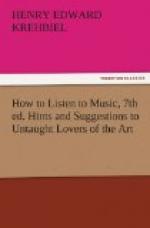[Sidenote: The Orchestral Suite.]
[Sidenote: Ballet music.]
The Suite has come back into favor as an orchestral piece, but the term no longer has the fixed significance which once it had. It is now applied to almost any group of short pieces, pleasantly contrasted in rhythm, tempo, and mood, each complete in itself yet disclosing an aesthetic relationship with its fellows. Sometimes old dance forms are used, and sometimes new, such as the polonaise and the waltz. The ballet music, which fills so welcome a place in popular programmes, may be looked upon as such a suite, and the rhythm of the music and the orchestral coloring in them are frequently those peculiar to the dances of the countries in which the story of the opera or drama for which the music was written plays. The ballets therefore afford an excellent opportunity for the study of local color. Thus the ballet music from Massenet’s “Cid” is Spanish, from Rubinstein’s “Feramors” Oriental, from “Aida” Egyptian—Oriental rhythms and colorings being those most easily copied by composers.
[Sidenote: Operatic excerpts.]
[Sidenote: Gluck and Vestris.]
The other operatic excerpts common to concerts of both classes are either between-acts music, fantasias on operatic airs, or, in the case of Wagner’s contributions, portions of his dramas which are so predominantly instrumental that it has been found feasible to incorporate the vocal part with the orchestral. In ballet music from the operas of the last century, some of which has been preserved to the modern concert-room, local color must not be sought. Gluck’s Greeks, like Shakespeare’s, danced to the rhythms of the seventeenth century. Vestris, whom the people of his time called “The god of the dance,” once complained to Gluck that his “Iphigenie en Aulide” did not end with a chaconne, as was the rule. “A chaconne!” cried Gluck; “when did the Greeks ever dance a chaconne?” “Didn’t they? Didn’t they?” answered Vestris; “so much the worse for the Greeks.” There ensued a quarrel. Gluck became incensed, withdrew the opera which was about to be produced, and would have left Paris had not Marie Antoinette come to the rescue. But Vestris got his chaconne.
VI
At a Pianoforte Recital
[Sidenote: Mr. Paderewski’s concerts.]
No clearer illustration of the magical power which lies in music, no more convincing proof of the puissant fascination which a musical artist can exert, no greater demonstration of the capabilities of an instrument of music can be imagined than was afforded by the pianoforte recitals which Mr. Paderewski gave in the United States during the season of 1895-96. More than threescore times in the course of five months, in the principal cities of this country, did this wonderful man seat himself in the presence of audiences,




